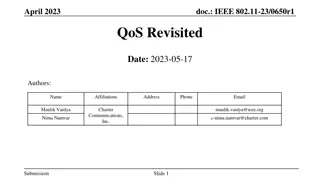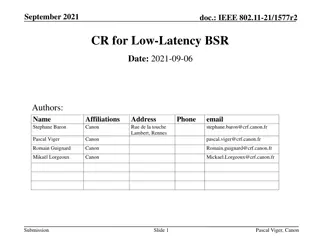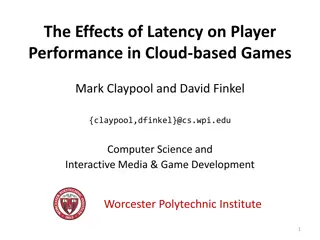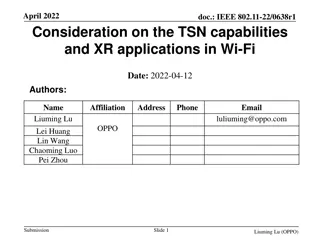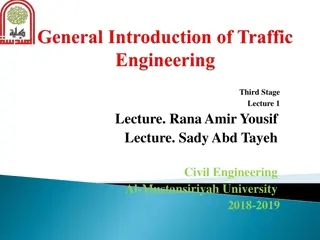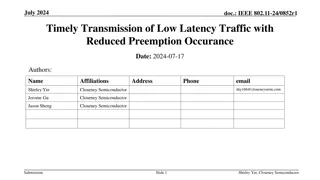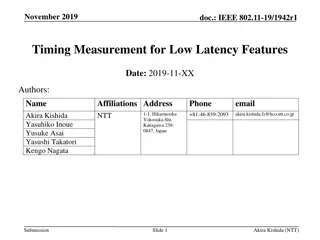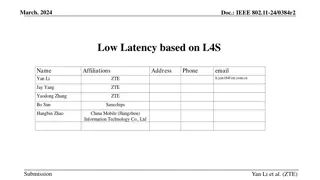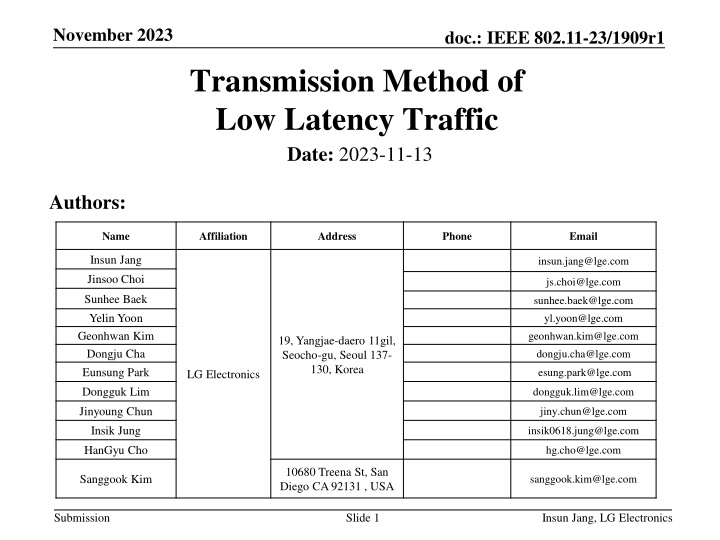
IEEE 802.11-23/1909r1 Transmission Method for Low Latency Traffic in November 2023
Explore the transmission method for low latency traffic in IEEE 802.11-23/1909r1 document dated November 13, 2023. The document discusses strategies such as preemption in TXOP and optimized scheduling to enhance the 95th percentile of latency distribution, focusing on improving low latency traffic delivery in UHR. Various mechanisms like Restricted TWT and Enhanced SCS are highlighted to address issues related to delivering low latency traffic within target delay bounds.
Download Presentation

Please find below an Image/Link to download the presentation.
The content on the website is provided AS IS for your information and personal use only. It may not be sold, licensed, or shared on other websites without obtaining consent from the author. If you encounter any issues during the download, it is possible that the publisher has removed the file from their server.
You are allowed to download the files provided on this website for personal or commercial use, subject to the condition that they are used lawfully. All files are the property of their respective owners.
The content on the website is provided AS IS for your information and personal use only. It may not be sold, licensed, or shared on other websites without obtaining consent from the author.
E N D
Presentation Transcript
November 2023 doc.: IEEE 802.11-23/1909r1 Transmission Method of Low Latency Traffic Date: 2023-11-13 Authors: Name Affiliation Address Phone Email Insun Jang Jinsoo Choi insun.jang@lge.com js.choi@lge.com Sunhee Baek Yelin Yoon Geonhwan Kim Dongju Cha Eunsung Park Dongguk Lim Jinyoung Chun Insik Jung HanGyu Cho sunhee.baek@lge.com yl.yoon@lge.com geonhwan.kim@lge.com dongju.cha@lge.com 19, Yangjae-daero 11gil, Seocho-gu, Seoul 137- 130, Korea esung.park@lge.com LG Electronics dongguk.lim@lge.com jiny.chun@lge.com insik0618.jung@lge.com hg.cho@lge.com 10680 Treena St, San Diego CA 92131 , USA Sanggook Kim sanggook.kim@lge.com Submission Slide 1 Insun Jang, LG Electronics
November 2023 doc.: IEEE 802.11-23/1909r1 Introduction According to the PAR for 11bn (UHR), we have an important goal that is to improve the 95th percentile of the latency distribution In UHR SG with the goal, many contributions have investigated method(s) based on different views in UHR, e.g., Classification/Prioritization of low latency (LL) traffic [1] Preemption of low latency traffic in TXOP [2]-[7] Optimized Scheduling [8], [9] EDCA channel access for Low Latency [10] Low Latency Traffic Out-of-Delivery [11], [12] In this contribution, we share our views on how to transmit low latency traffic (LLT) based on preemption in a TXOP Submission Slide 2 Insun Jang, LG Electronics
November 2023 doc.: IEEE 802.11-23/1909r1 Recap: Restricted TWT and SCS in 11be In 11be, based on a lot of discussions on low latency, we had main mechanisms: Restricted TWT for transmitting LLT with negotiated TID and TXOP rules Enhanced SCS for specifying traffic characteristics/pattern and prioritizing the traffic with a QoS characteristics IE in terms of DL/UL/Direct Thanks to those mechanisms, the AP can properly schedule frame transmission/rTWT by referencing QoS characteristics IE Even though those can reduce the latency on average, we still have some issues on the delivery of some LLT under target delay bound (e.g., non-deterministic/event- driven LLT) [13] on pre-determined schedule The detailed issue is shown in the next slide Submission Slide 3 Insun Jang, LG Electronics
November 2023 doc.: IEEE 802.11-23/1909r1 Basic Issue A STA may need to transmit LLT to one or more target STA(s) Such LLT has just arrived or already queued with requirements (e.g., it should be transmitted TX within Xus, quickly) Basically, while the STA would perform EDCA, the STA can experience the followings: Significantly congested channel and NAV by the (long) TXOP by another STA As a result, the LLT can be out-of-date before obtaining a TXOP We can consider the issue on how a STA can transmit LLT to satisfy the LLT requirements even though another STA has already occupied the channel (called Preemption) Slide 4 Submission Insun Jang, LG Electronics
November 2023 doc.: IEEE 802.11-23/1909r1 What We Should Handle Generally, we can have 3 phases 1st Negotiation Capabilities for Preemption of LLT TX Restrictions, e.g., what kind of LLT can be transmitted or which STA can transmit based on the preemption (e.g., using SCS/rTWT, LLT classification) to avoid non-LLT TX 2nd Preemption How a STA can transmit LLT in a TXOP of another STA 3rd (Post) Management Depending on the case, we may give an incentive to TXOP holder (who triggered LLT TX) or may impose a penalty to TXOP responder (who transmitted LLT) Submission Slide 5 Insun Jang, LG Electronics
November 2023 doc.: IEEE 802.11-23/1909r1 Overview of Preemption Phase Basically, a TXOP holder can transmit its LLT to one or more TXOP responder(s) anytime in its TXOP However, without the aid of TXOP holder in most of cases, TXOP responder cannot transmit LLT to target STA(s) when needed e.g., to AP without Trigger frame Other STAs (not TXOP responder) cannot transmit LLT to target STA(s) Therefore, we need mechanism(s) where the TXOP holder can provide opportunities for the TXOP responder or other STA(s) to transmit urgent LLT in its own TXOP In this document, we consider the cases, i.e., TXOPs obtained by AP or non-AP STA (DL TXOP or UL TXOP) Submission Slide 6 Insun Jang, LG Electronics
November 2023 doc.: IEEE 802.11-23/1909r1 Observations on UL TXOP During an UL TXOP, an AP (TXOP responder) may need to transmit LLT to target STAs (including STA 1 (TXOP holder)), which requires that STA 1 needs to share the TXOP with the AP On TXOP holder (STA 1) side, STA 1 needs to transmit Triggering Information that would indicate at least it asks if the TXOP responder (AP) needs to transmit LLT using its TXOP On TXOP responder (AP) side, (In response to Triggering Information), AP needs to transmit LLT Information that would indicate at least it needs to transmit LLT using the current TXOP to STA TXOP responder may provide additional information, e.g., LLT buffer status, delay bound Such information could be transmitted in a unsolicited way without triggering info Submission Slide 7 Insun Jang, LG Electronics
November 2023 doc.: IEEE 802.11-23/1909r1 Preemption Signaling in UL TXOP We should design where and how the Info can be carried carefully Triggering Info can be carried in a triggering PPDU/frame (e.g., PHY header, Trigger frame) LLT Info can be carried in a responding frame (e.g., control response frame) For example, the AP can utilize transmitting BA frames including the information of LLT presence Submission Slide 8 Insun Jang, LG Electronics
November 2023 doc.: IEEE 802.11-23/1909r1 Preemption Signaling in UL TXOP As an alternative without Triggering Info, during frame exchanges, the AP may inform the TXOP holder (STA 1) of LLT presence, e.g., through BA frame It could help the STA grant its TXOP to the AP The STA identifying the information may transmit a frame that enables LLT transmission from the AP The STA may provide additional information, e.g., available duration in TXOP Submission Slide 9 Insun Jang, LG Electronics
November 2023 doc.: IEEE 802.11-23/1909r1 Observations on DL TXOP During a DL TXOP, a STA 1 (TXOP responder) or other STAs may need to transmit LLT to AP (TXOP holder), which requires that the AP needs to trigger LLT TX On TXOP holder (AP) side, AP needs to transmit a Triggering Information would indicate at least it asks if the TXOP responder and other STA(s) needs to transmit LLT TXOP holder may provide additional information, e.g., criteria of LLT Info TX On TXOP responder (STA 1) or other STA(s) side, (In response to Triggering Information), the STAs need to transmit LLT Information that would indicate at least it needs to transmit LLT to AP Recipient STA(s) may provide additional information, e.g., LLT buffer status, delay bound Such information could be transmitted in a unsolicited way without triggering info Submission Slide 10 Insun Jang, LG Electronics
November 2023 doc.: IEEE 802.11-23/1909r1 Preemption Signaling in DL TXOP Likewise, we should design where and how the Info can be carried Triggering Info can be carried in a triggering frame (e.g., Trigger frame, PHY header) that should be a method to trigger the LLT Info from multiple STAs LLT Info can be carried in a responding frame (e.g., using A-control, control response frame) Depending on the design of Triggering Info, channels on which STAs transmit LLT Info can be overlapped (e.g., PHY header) or non-overlapped (e.g., Trigger frame), which may require to identify STAs Submission Slide 11 Insun Jang, LG Electronics
November 2023 doc.: IEEE 802.11-23/1909r1 Discussion on LLT Info TX TXOP holder can expect no response from any STA due to following reasons Any STA has no LLT to be transmitted, so no LLT Info TX TXOP responder(s) does not acknowledge (Triggering info is transmitted with QoS Data frame(s) with Ack policy not setting to implicit BAR or Normal Ack) In this case, PIFS can be used between Triggering Info [2]-[6] However, the TXOP holder does not understand whether it is no LLT Info or failure that would degrade the performance Therefore, it should require CCA during PIFS, e.g., if BUSY (not decoding any LLT info), it will perform recovery procedures Submission Slide 12 Insun Jang, LG Electronics
November 2023 doc.: IEEE 802.11-23/1909r1 Discussion on LLT Info TX If at least one TXOP responder performs acknowledgement (e.g., BA), SIFS can be used TXOP holder can understand it is failure if nothing is received and then recovery will be performed The TXOP responder could indicate LLT Info with acknowledgement (e.g., in BA) Submission Slide 13 Insun Jang, LG Electronics
November 2023 doc.: IEEE 802.11-23/1909r1 Further Issues for Preemption Detailed Design Signaling of Triggering Info and LLT Info LLT Info Transmission with a Proper interval Restrictions/Rules All STAs and their all traffic should not be involved in preemption all the time, e.g., a STA may request LLT TX for non-LLT We need to consider what kind of specific things are involved in preemption Power Saving Some STAs may enter doze state during a preemption procedure, e.g., STAs that did not receive TIM indication in UL TXOP, which may be handled Submission Slide 14 Insun Jang, LG Electronics
November 2023 doc.: IEEE 802.11-23/1909r1 Conclusion In this contribution, we ve shared our views on how to transmit low latency traffic (LLT) based on preemption in a TXOP It efficiently enables LLT transmission of a STA in another STA s TXOP UL TXOP and DL TXOP can be considered We need Triggering Info and LLT Info to enable preemption In addition, whether LLT Info is transmitted should be considered Some further issues should be addressed How to signal Triggering Info and LLT Info How to handle LLT Info transmission with a proper interval How to participate/negotiate preemption based on restrictions/rules Submission Slide 15 Insun Jang, LG Electronics
November 2023 doc.: IEEE 802.11-23/1909r1 Straw Poll 1 Do you agree that 11bn supports a mechanism where A TXOP holder solicits the information about whether low latency traffic is desired to be transmitted from a STA associated with the TXOP holder so that the TXOP holder can allow the STA to transmit low latency traffic in its TXOP? TXOP holder can be an AP or a non-AP STA Signaling is TBD Submission Slide 16 Insun Jang, LG Electronics
November 2023 doc.: IEEE 802.11-23/1909r1 Straw Poll 2 Do you agree that 11bn supports a mechanism where A STA, which is not a TXOP holder and associated with the TXOP holder, indicates the information about whether low latency traffic is desired to be transmitted to the TXOP holder? TXOP holder can be an AP or a non-AP STA Signaling is TBD Submission Slide 17 Insun Jang, LG Electronics
November 2023 doc.: IEEE 802.11-23/1909r1 References [1] 11-23/69r1, Considerations on Latency Improvement [2] 11-23/18r1, Low latency support in UHR [3] 11-23/1174r0, TXOP preemption follow up [4] 11-23/92r0, Preemption for Low Latency Application [5] 11-23/1229r1, Preemption for low latency application (Follow up) [6] 11-23/798r0, Low latency traffic report [7] 11-23/1434r2, Discussions on Low Latency Traffic Delivery in UHR [8] 11-23/936r0, Medium efficient scheduled channel access in next generation 802.11 [9] 11-22/1923r1, Enhanced Trigger-Based Uplink Transmission [10] 11-22/1065r0, Low latency channel access [11] 11-23/697r0, QoS enhancements for UHR [12] 11-23/799r0, Low latency out-of-order delivery [13] 11-22/1880, Latency and Reliability enhancements for UHR Submission Slide 18 Insun Jang, LG Electronics

